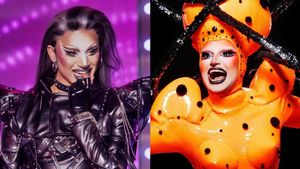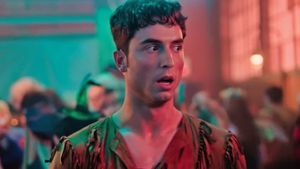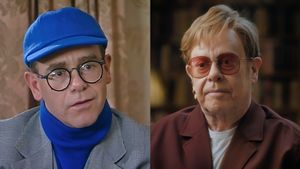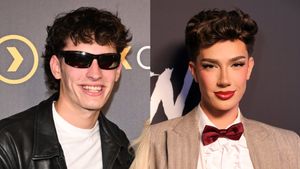Picture it: 18th century Brittany, France. Marianne (Noémie Merlant) arrives to paint a wedding portrait of Héloïse (Adèle Haenel), the daughter of a wealthy Italian countess (Valeria Golino). Héloïse isn’t particularly cooperative with posing, so Marianne is instructed not to let her subject know the purpose of the visit. She accompanies Héloïse on her daily walks and studies her face and body language with the intent to use her memory to construct the perfect image. Things don’t go as planned. Their daily walks elevate curiosity to desire as concepts of love, class, and femininity surround the two in a romance for the ages. That is Céline Sciamma’s new film, Portrait of a Lady on Fire.
I saw Portrait at the Cannes Film Festival earlier this year and fell in love with this unconventional period piece, so I was excited to see it once more at the Toronto International Film Festival. I don’t say this lightly: it’s a film worth seeing more than once.
The day after its North American debut, I waited outside Toronto's Intercontinental Hotel with bated breath for my interview with the film's director Céline Sciamma and its two stars Noémie Merlant and Adèle Haenel. I knew our time would be limited so I needed to make sure I got straight to the point. I’m not easily starstruck, but these are three women whose work I greatly admire, and I was excited to ask some burning questions that have been on my mind for months. Just like in the film, curiosity begat the desire to learn more about the process—and how they control the narrative.
PRIDE: Was it difficult to get funding in France to make the film? In Hollywood, studios are always questioning the purpose of women's work and its right to exist, no matter the budget, so I’d like to know if France is any different.
Sciamma: Well, the budget for the film was 4 million Euros and since we were aiming to fund this with public money, I didn’t have that difficulty. Maybe if I were making a blockbuster film or a film with a budget of over 6 million that would be different, but I didn’t have my work questioned. It helps that this is my fourth film.
Héloïse comes from a convent and Marianne is a painter. How did you come up with the circumstances for each character? These are quite unique situations for both characters to be in, and you could have gone with anything...
Sciamma: That's a good question. I created them not to be characterized. We don't know much about them and that’s by design because the less we know, the more we can imagine. For example, we only know that Héloïse left the convent but we don’t know why. We can guess she left because of circumstances at home, though that’s not quite clear. With Marianne, we know that she is the daughter of a successful painter and with the societal makeup of the time, women were not allowed to have those skills unless they were linked to a man. I kept their backgrounds basic, so the audience can focus on who they are in the moment. Other things I keep secret for myself.
That leads me to my next question for Adèle Haenel. While getting to know your Héloïse and her current struggles, it’s easy to see that she doesn’t have control over her life. So when preparing for the role, did you have secret plans about how your character would gain back agency and control over her life?
Haenel: It’s the assumption that you're supposed to give a background to your character, and to have a very clear vision. For me, it wasn’t like that. I tried to create Héloïse in my head so that it felt like a representation of someone through the gaze of someone else. At the beginning, I’m using my face as a mask because the character knows she is powerless regarding her destiny.
Maybe it’s a defense mechanism? I mean, as an 18th century woman, what options does she have…
Haenel: There are some options. First, there’s violence, but the patriarchal system is too strong. It's an unequal fight that she will lose. Second, Héloïse cannot live in a world that does not want her to be alive, so the next option is suicide. The last option is to give into the system and let it crush you.
Marianne doesn’t have that dilemma though. As a painter, Marianne appears autonomous. She is free to control the gaze of those around her. How she conceives and constructs art is something I’ve never seen done before in film. When developing your character, what aspects of painting stood out for you?
Merlant: I didn't know all the steps or the technical stuff that’s part of the process. What stands out most to me is learning the gaze of the painter, the way you look to the object of focus, and all the steps of the painting process. From gathering the colors, to following the lines, the shadow, and the light.
What’s the preparation like for a painter’s artistic cadence?
Merlant: A big part of preparation was getting the rhythm between the model, the brush, and the canvas. In many ways it’s like a dance. As a painter you have to step back, look at everything, and then step back in to get the details and the truth of the motions.
One thing that stood out for me was the film’s ability to subvert so many harmful tropes and stereotypes that plague queer cinema and lesbian cinema specifically. How did you avoid boxing yourselves into a corner with this story and these characters? How did you make it stand out from what already exists in the lesbian and the romance genres?
Sciamma: I'm always obsessed with the fact that things should be new. When you do period pieces, it’s easy to fall into conventional habits. These tropes are about power dynamics and conflicts of power, but Portrait focused on equality and compassion. That was my goal. I think this freed me from a lot of other conventions the story could fall into.
Haenel: I try to take roles that aren’t psychological constrictions of characters because I can’t define what that means. It doesn’t relate to the way I enter this or any movie. I prefer to think of character as a question with a hypothetical answer with no stereotypes attached.
Portrait of a Lady on Fire will hit select theaters on December 6. Watch the trailer in the video below.































































































































